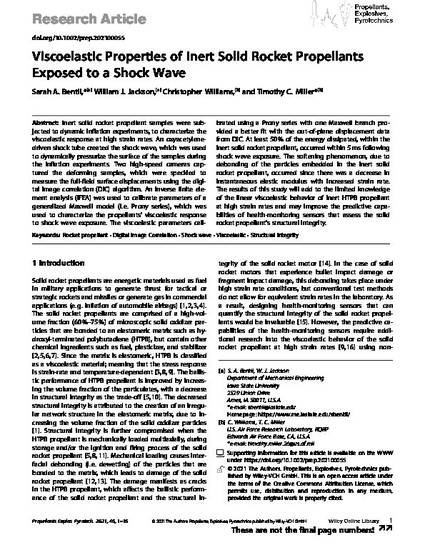
Inert solid rocket propellant samples were subjected to dynamic inflation experiments, to characterize the viscoelastic response at high strain rates. An oxyacetylene-driven shock tube created the shock wave, which was used to dynamically pressurize the surface of the samples during the inflation experiments. Two high-speed cameras captured the deforming samples, which were speckled to measure the full-field surface displacements using the digital image correlation (DIC) algorithm. An inverse finite element analysis (iFEA) was used to calibrate parameters of a generalized Maxwell model (i. e. Prony series), which was used to characterize the propellants’ viscoelastic response to shock wave exposure. The viscoelastic parameters calibrated using a Prony series with one Maxwell branch provided a better fit with the out-of-plane displacement data from DIC. At least 50 % of the energy dissipated, within the inert solid rocket propellant, occurred within 5 ms following shock wave exposure. The softening phenomenon, due to debonding of the particles embedded in the inert solid rocket propellant, occurred since there was a decrease in instantaneous elastic modulus with increased strain rate. The results of this study will add to the limited knowledge of the linear viscoelastic behavior of inert HTPB propellant at high strain rates and may improve the predictive capabilities of health-monitoring sensors that assess the solid rocket propellant's structural integrity.
Available at: http://works.bepress.com/sarah-bentil/12/

This is the published version of the following article: Bentil, Sarah A., William J. Jackson, Christopher Williams, and Timothy C. Miller. "Viscoelastic Properties of Inert Solid Rocket Propellants Exposed to a Shock Wave." Propellants, Explosives, Pyrotechnics 46 (2021). DOI: 10.1002/prep.202100055.